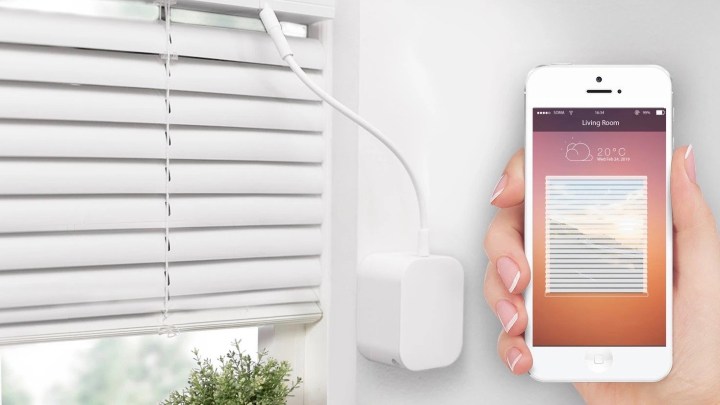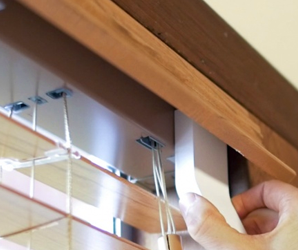Smart homes are more popular than ever, with companies like Google, Amazon, Ring, Arlo, and other big brands churning out new products at regular intervals. Most people have heard of smart displays and smart light bulbs — but smart blinds are yet to gain the same traction as these other categories.
However, smart blinds can become an integral part of any smart home. Along with giving you an easy way to manipulate your shades, they can help you save money by allowing (or limiting) light to enter your home and moderate its temperature.
One of the main limitations of smart blinds is their price, as getting custom shades fitted and installed can be expensive and time-consuming. But with some DIY skills and the right products, you can turn most existing blinds into smart blinds.
Here’s how to convert your window blinds into smart blinds, including details on the components you’ll need, why you should consider converting to smart blinds, and all the benefits you’ll get from the unique product.
What is a smart blind?

Smart blinds are just window blinds that you can open and close via an app, voice control, or another smart method rather than physically doing it by hand. Smart blinds are useful in that you can schedule them to open and close or raise and lower at set times of the day or in response to other inputs. For example, you can connect a UV sensor to your smart blinds to close when the light reaches a certain point in your home.
The downside is that smart blinds tend to be pricy, and equipping every window in your home with smart blinds can definitely make a dent in your wallet.
Why should I get smart blinds?
Smart blinds can keep your home more comfortable and reduce energy costs by blocking out sunlight during the hottest parts of the day. They can help you stay cool during the summer and trap heat during the winter. They can also reduce the glare on screens without you needing to fiddle with drawstrings manually. Smart blinds are a great way to wake you up with natural light in the mornings once you set some schedules.
Smart blinds can even help you save money and are typically worth the hefty upfront investment. Using a DIY kit to convert your existing blinds into smart shades is an excellent way to cut down on expenses while still helping you lower energy bills every month.
What types of smart blinds are there?
Since blinds use a wide range of mechanisms to open and close, smart blind upgrades are equally diverse.
The simplest, like the Soma Smart Shades, attach directly to the drawstring and drive it up or down on command. These kinds of smart blinds are super easy to install. Others attach on a horizontal track to draw curtains or blinds directly. These are just about as easy to install, minus the need to reach above and align on the tracks.
The more involved systems replace your entire blind system and have a built-in motor. It’s more complicated to set up but produces a more seamless look. Tilt’s MySmartRollerShade is a prime example of this format.
You could also consider one of the many products offered by SwitchBot, which are designed to convert a wide range of existing blinds. For example, the SwitchBot Curtain 3 will open or close curtains installed on sliding glass doors, while the SwitchBot Blind Tilt will automatically angle your traditional blinds based on how much sun is entering your room.
In other words, there’s likely a DIY product that’s compatible with your existing setup — so if you’re happy with your blinds but wish they were smarter, there’s no need to shop around for costly replacements. Instead, a DIY upgrade kit is a great solution.
Are smart blinds easy to install?

Smart blinds are relatively easy to install. Many of them mount to the window frame like regular blinds, with the only caveat being that they require batteries. Other smart blinds use a rechargeable pack that you can plug in when the power is low.
If you can install traditional blinds, you can install smart blinds. The exception is that smart blinds are hardwired into your wall. In many cases, this requires electrical work that many people are not comfortable doing — nor should they attempt doing it on their own. In a situation like this, an electrician might need to do the wiring before you install the blinds.
Battery life depends on how often you open and close the smart blinds, and it will of course vary between companies. Users of the Ikea Fyrtur smart blinds report an average of two to three months on a single charge.
Installation does become slightly more complicated when you set up DIY smart blinds. Many DIY kits make installation as easy as possible, but they still require removing your blinds and installing a motor inside the housing. If you aren’t much of a tinkerer, this can feel like a daunting task.
What components are involved in smart blinds?
The main component involved in smart blinds is the motor. Some kits are just that: A motor and nothing else. In this case, the various sensors and receivers for smart functionality are built into the motor. In other cases, those components are separate.
Some smart blinds also include a solar panel to provide nearly unlimited power. This solution removes the need for any hardwiring or battery packs and is a much preferable option over more complicated installations.
If your blinds use a pulley system to raise and lower them, some kits are as easy as attaching a motor to your wall below the blinds. This motor pulls the cord to raise or lower the blinds. It can also be outfitted to open and close them.
Blind technology is about as straightforward as it comes, but you can outfit DIY kits with sensors to make them work with smart assistants and other devices.
How are smart blinds controlled?
The majority of smart blinds are controlled through a remote control, an app, or a voice assistant.
Amazon Alexa and Google Assistant are the two most compatible voice assistants. There are a limited number of options that are compatible with Apple HomeKit. The Lutron Serena works with HomeKit, as do the Ikea Fyrtur and Kadrilj smart blinds. Some DIY kits may work with smart blinds, but the options are limited. The widest range of compatibility we’ve seen with DIY kits are those that people have built completely from the ground up.
Are there smart blind automations?
If you buy smart blinds off the shelf, there are a lot of different automations you can set up. Even those that lack compatibility can often be tweaked as long as they work with Alexa or Google Assistant.
There are also IFTTT automations already made on the site. Blinds can be set up to open or close based on time of day, temperature, light level, and a number of other settings.
Even DIY kits can be set up to work with other devices. Depending on the kit you buy, it might work with Alexa or another system out of the box. For example, the MySmartBlinds Automation Kit Bundle and the Brunt Smart Motorized Blind both work with Alexa.
What are the benefits of having DIY smart blinds?
The primary benefit of DIY smart blinds is the price. The Tilt MySmartRollerShades are $400 per blind. The Brunt Blind Engine, a DIY kit for blinds with a pulley system, is only $99. If you try to equip every window in your home with smart blinds, the less expensive option is a much better bet.
You don’t have to spend a fortune to equip your home with smart blinds. You can opt for a DIY kit to transform your existing blinds into smart blinds, or you can go for a budget option, like Ikea’s Fyrtur blinds at around $150 per window.
Editors' Recommendations
- Best electric toothbrush deals: Save on Colgate, Quip and Oral-B
- Best Instant Pot deals: Pressure cookers, air fryers and grills on sale
- Should you buy a new smart lock or retrofit your existing deadbolt?
- Best vacuum deals: Cordless to corded, Dyson to Bissell
- Best air purifier deals: Save big on Dyson, Shark, TCL and more




